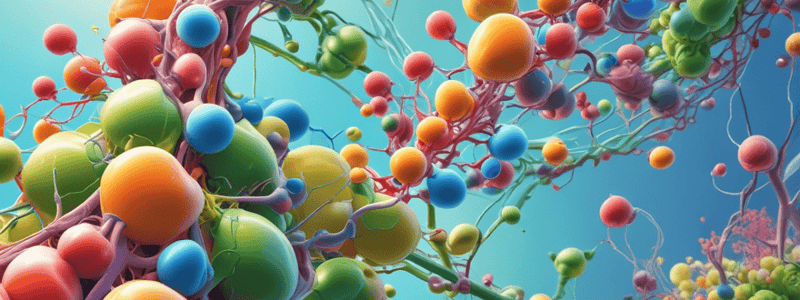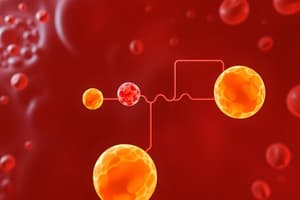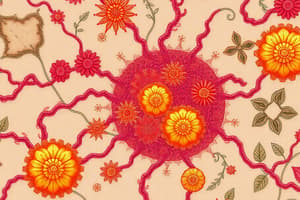Podcast
Questions and Answers
Which of the following is NOT a characteristic of the glycolysis pathway?
Which of the following is NOT a characteristic of the glycolysis pathway?
- Converts glucose to 2 pyruvate molecules
- Involves the organization of enzymes within the cell to allow for substrate channeling (correct)
- Occurs in the cytoplasm of eukaryotic cells
- Generates 4 ATP molecules, with 2 ATP consumed
What is the primary purpose of the trapping and preparation phase (Stage 1) of glycolysis?
What is the primary purpose of the trapping and preparation phase (Stage 1) of glycolysis?
- To release toxic intermediates
- To convert glucose to fructose 1,6-bisphosphate (correct)
- To generate ATP
- To allow for the movement of substrates and products through the enzymes
What is the primary function of the enzyme hexokinase in the glycolysis pathway?
What is the primary function of the enzyme hexokinase in the glycolysis pathway?
- To isomerize glucose 6-phosphate to fructose 6-phosphate
- To generate ATP from the oxidation of glyceraldehyde 3-phosphate
- To convert glucose to glucose 6-phosphate (correct)
- To cleave fructose 1,6-bisphosphate into two 3-carbon molecules
What is the primary purpose of the second phosphorylation step in Stage 1 of glycolysis?
What is the primary purpose of the second phosphorylation step in Stage 1 of glycolysis?
What is the primary purpose of the isomerization step in Stage 1 of glycolysis?
What is the primary purpose of the isomerization step in Stage 1 of glycolysis?
What is the primary purpose of the ATP consumption during Stage 1 of glycolysis?
What is the primary purpose of the ATP consumption during Stage 1 of glycolysis?
What is the primary purpose of the substrate channeling that occurs in the glycolysis pathway?
What is the primary purpose of the substrate channeling that occurs in the glycolysis pathway?
Which of the following is NOT a characteristic of the ATP harvesting stage (Stage 2) of glycolysis?
Which of the following is NOT a characteristic of the ATP harvesting stage (Stage 2) of glycolysis?
What is the primary difference between prokaryotic and eukaryotic glycolysis?
What is the primary difference between prokaryotic and eukaryotic glycolysis?
Which of the following is NOT a product of the glycolysis pathway?
Which of the following is NOT a product of the glycolysis pathway?
Which enzyme catalyzes the irreversible conversion of fructose 6-phosphate to fructose 1,6-bisphosphate in glycolysis?
Which enzyme catalyzes the irreversible conversion of fructose 6-phosphate to fructose 1,6-bisphosphate in glycolysis?
What is the key regulatory enzyme for glycolysis?
What is the key regulatory enzyme for glycolysis?
Which enzyme is responsible for converting 2-phosphoglycerate into phosphoenolpyruvate in glycolysis?
Which enzyme is responsible for converting 2-phosphoglycerate into phosphoenolpyruvate in glycolysis?
What is the final product formed by the irreversible conversion of pyruvate through pyruvate kinase?
What is the final product formed by the irreversible conversion of pyruvate through pyruvate kinase?
What fate does pyruvate have in cellular respiration if oxygen is present?
What fate does pyruvate have in cellular respiration if oxygen is present?
What is the net reaction for lactic acid fermentation when pyruvate forms lactate?
What is the net reaction for lactic acid fermentation when pyruvate forms lactate?
Which enzyme catalyzes the conversion of galactose into galactose 1-phosphate in the Galactose-Glucose Interconversion Pathway?
Which enzyme catalyzes the conversion of galactose into galactose 1-phosphate in the Galactose-Glucose Interconversion Pathway?
'Stage 1 of glycolysis ends with the cleavage of fructose 1,6-bisphosphate into ______.' Fill in the blank.
'Stage 1 of glycolysis ends with the cleavage of fructose 1,6-bisphosphate into ______.' Fill in the blank.
What is the product formed when phosphoenolpyruvate transfers its phosphoryl group to ADP?
What is the product formed when phosphoenolpyruvate transfers its phosphoryl group to ADP?
What is the key role of glycolysis?
What is the key role of glycolysis?
Which enzyme catalyzes the conversion of glucose 1-phosphate to glucose 6-phosphate in glycolysis?
Which enzyme catalyzes the conversion of glucose 1-phosphate to glucose 6-phosphate in glycolysis?
Which enzyme in glycolysis regulation is a critical control site in muscle?
Which enzyme in glycolysis regulation is a critical control site in muscle?
What is the primary location for gluconeogenesis?
What is the primary location for gluconeogenesis?
Which enzymes regulate the balance between glycolysis and gluconeogenesis in the liver?
Which enzymes regulate the balance between glycolysis and gluconeogenesis in the liver?
Which enzyme catalyzes the conversion of UDP-Galactose to UDP-glucose?
Which enzyme catalyzes the conversion of UDP-Galactose to UDP-glucose?
How are glucose transporters involved in cellular processes?
How are glucose transporters involved in cellular processes?
What is the end product of galactose metabolism involving UDPglucose?
What is the end product of galactose metabolism involving UDPglucose?
In what cellular process is UDP-Glucose involved?
In what cellular process is UDP-Glucose involved?
What is the primary source of the uridyl group for the conversion of galactose 1-phosphate to UDP-galactose?
What is the primary source of the uridyl group for the conversion of galactose 1-phosphate to UDP-galactose?
Which enzyme catalyzes the interconversion between UDP-galactose and UDP-glucose?
Which enzyme catalyzes the interconversion between UDP-galactose and UDP-glucose?
What is the primary function of phosphoglucomutase in glycolysis?
What is the primary function of phosphoglucomutase in glycolysis?
Which of the following is NOT a role of glycolysis?
Which of the following is NOT a role of glycolysis?
Which of the following enzymes is NOT a key regulator of glycolysis?
Which of the following enzymes is NOT a key regulator of glycolysis?
In muscle cells, what is the primary mechanism for regulating glycolysis?
In muscle cells, what is the primary mechanism for regulating glycolysis?
What is the primary biochemical function of glycolysis regulation in the liver?
What is the primary biochemical function of glycolysis regulation in the liver?
Which of the following glucose transporters is primarily responsible for glucose uptake in insulin-sensitive tissues like muscle and adipose tissue?
Which of the following glucose transporters is primarily responsible for glucose uptake in insulin-sensitive tissues like muscle and adipose tissue?
What is the primary substrate for gluconeogenesis?
What is the primary substrate for gluconeogenesis?
Which enzymes play a key role in regulating the balance between glycolysis and gluconeogenesis in the liver?
Which enzymes play a key role in regulating the balance between glycolysis and gluconeogenesis in the liver?
What is the primary advantage of trapping glucose inside the cell during Stage 1 of glycolysis?
What is the primary advantage of trapping glucose inside the cell during Stage 1 of glycolysis?
Which of the following statements about Stage 1 of glycolysis is correct?
Which of the following statements about Stage 1 of glycolysis is correct?
What is the primary purpose of the isomerization step in Stage 1 of glycolysis?
What is the primary purpose of the isomerization step in Stage 1 of glycolysis?
Which of the following is NOT a function of substrate channeling in glycolysis?
Which of the following is NOT a function of substrate channeling in glycolysis?
What is the primary role of the second phosphorylation step in Stage 1 of glycolysis?
What is the primary role of the second phosphorylation step in Stage 1 of glycolysis?
Which of the following statements about Stage 2 of glycolysis is correct?
Which of the following statements about Stage 2 of glycolysis is correct?
Which of the following statements about the enzyme hexokinase is correct?
Which of the following statements about the enzyme hexokinase is correct?
What is the primary advantage of the organization of enzymes in glycolysis?
What is the primary advantage of the organization of enzymes in glycolysis?
Which of the following statements about glycolysis is correct?
Which of the following statements about glycolysis is correct?
What is the primary purpose of the trapping and preparation phase (Stage 1) of glycolysis?
What is the primary purpose of the trapping and preparation phase (Stage 1) of glycolysis?
What is the net reaction for lactic acid fermentation when pyruvate forms lactate?
What is the net reaction for lactic acid fermentation when pyruvate forms lactate?
Which enzyme catalyzes the phosphorylation of galactose into galactose 1-phosphate in the Galactose-Glucose Interconversion Pathway?
Which enzyme catalyzes the phosphorylation of galactose into galactose 1-phosphate in the Galactose-Glucose Interconversion Pathway?
What is the fate of pyruvate in cellular respiration when oxygen is present?
What is the fate of pyruvate in cellular respiration when oxygen is present?
Which enzyme catalyzes the conversion of fructose to glycolytic intermediates in the liver through the fructose 1-phosphate pathway?
Which enzyme catalyzes the conversion of fructose to glycolytic intermediates in the liver through the fructose 1-phosphate pathway?
What is the primary role of alcohol dehydrogenase in ethanol fermentation?
What is the primary role of alcohol dehydrogenase in ethanol fermentation?
What is the primary function of lactate dehydrogenase in lactic acid fermentation?
What is the primary function of lactate dehydrogenase in lactic acid fermentation?
Which enzyme catalyzes the conversion of glyceraldehyde into glyceraldehyde 3-phosphate that enters glycolysis?
Which enzyme catalyzes the conversion of glyceraldehyde into glyceraldehyde 3-phosphate that enters glycolysis?
What is the primary role of phosphoglycerate mutase in glycolysis?
What is the primary role of phosphoglycerate mutase in glycolysis?
Flashcards are hidden until you start studying
Study Notes
Glycolysis: Common Pathway
- Occurs in the cytoplasm of eukaryotic cells
- Glucose is converted to 2 pyruvate and 2 ATP
- 4 ATP are made, but 2 are consumed
- Enzymes are organized to allow for substrate channeling, ensuring the movement of substrates and products through enzymes and preventing the release of toxic intermediates
Two Stages of Glycolysis
Stage 1: Trapping and Preparation Phase
- No ATP is generated, but some is invested
- Conversion of glucose to fructose 1,6-bisphosphate
- Three steps:
- Phosphorylation (uses ATP) produces glucose 6-phosphate, trapping glucose inside the cell
- Isomerization
- Second phosphorylation (uses ATP) produces a compound that can be cleaved into two phosphorylated 3-carbon molecules
- Completed with the cleavage of fructose 1,6-bisphosphate into:
- Glyceraldehyde 3-phosphate
- Dihydroxyacetone phosphate (converted to glyceraldehyde 3-phosphate)
Key Enzymes in Glycolysis
Hexokinase
- Transfers phosphoryl group from ATP to glucose, forming glucose 6-phosphate
- Added to the hydroxyl group on carbon 6
- Allows for two things:
- Prevents glucose from leaving the cell through the transporter it came in through (no longer the same substrate)
- Enables the cell to utilize glucose for energy production
Regulation of Glycolysis
In Muscle Cells
- Energy charge of the cell is the primary control of glycolysis
- Ratio of ATP to AMP
- Phosphofructokinase is the most important control site
- Allosteric inhibition by ATP
- AMP reverses the inhibitory action
- Inhibited by a decrease in pH (caused by the buildup of lactic acid)
In Liver Cells
- Corresponds to the biochemical versatility of the liver
- Phosphofructokinase is regulated by ATP, but drops in ATP are not typically experienced in the liver
- Citrate inhibits phosphofructokinase
- Fructose 2,6-bisphosphate is an activator of phosphofructokinase
- Form of feedforward stimulation
Gluconeogenesis
- Synthesis of glucose from non-carbohydrate precursors
- Critical to maintain blood glucose levels
- Glucose is the primary fuel for the brain
- Glucose is the only fuel for red blood cells
- Glycogen reserves can supply glucose for about a day
- Primarily occurs in the liver and, to a lesser degree, in the kidney
- Glucose produced by gluconeogenesis helps supply the brain, skeletal muscle, or heart muscle
Regulation of Gluconeogenesis
- Not a complete reversal of glycolysis
- Must bypass the three irreversible reactions of glycolysis
- The conversion of pyruvate into phosphoenolpyruvate begins with the formation of oxaloacetate
- Oxaloacetate is shuttled into the cytoplasm and converted into phosphoenolpyruvate
- The conversion of fructose 1,6-bisphosphate into fructose 6-phosphate and orthophosphate is an irreversible step
- The generation of free glucose is an important control point
- Fructose 6-phosphate is readily converted into glucose 6-phosphate
- Glucose 6-phosphate is transported into the lumen of the endoplasmic reticulum
- Glucose 6-phosphate is hydrolyzed into glucose by glucose 6-phosphatase
- Glucose and Pi are shuttled back to the cytoplasm by a pair of transporters### Galactose and Glucose Metabolism
- Galactose 1-phosphate acquires a uridyl group from UDP-glucose, producing UDP-galactose and glucose 1-phosphate, catalyzed by galactose 1-phosphate uridyl transferase.
- UDP-galactose is converted to UDP-glucose by UDP-galactose 4-epimerase, which inverts the hydroxyl group at carbon 4.
Regulation of Glycolysis
- Glycolysis has two main roles: breaking down glucose to form ATP and providing building blocks for biosynthetic reactions.
- The pathway is regulated by allosteric effectors or covalent modification, with enzymes that catalyze irreversible reactions being sites of control.
- Key regulatory enzymes in glycolysis include:
- Hexokinase: inhibited by its own product, glucose 6-phosphate.
- Phosphofructokinase: most important control site in mammals, inhibited by ATP and activated by AMP.
- Pyruvate kinase: regulated by ATP, fructose 1,6-bisphosphate, and alanine.
Glycolysis in Muscle and Liver
- In muscle, glycolysis is regulated by feedback inhibition to meet the need for ATP, with phosphofructokinase and pyruvate kinase being key regulatory enzymes.
- In liver, glycolysis is regulated by the biochemical versatility of the liver, with phosphofructokinase, hexokinase, and pyruvate kinase being regulated differently than in muscle.
Glucose Transport
- Glucose transporters allow for diffusion of glucose across the plasma membranes of animal cells.
- Different types of glucose transporters are found in different tissues, including:
- GLUT1 and GLUT3: found in nearly all mammalian cells.
- GLUT2: found in liver and pancreatic beta cells.
- GLUT4: found in muscle and fat cells.
- GLUT5: found in the small intestine.
Gluconeogenesis
- Gluconeogenesis is the synthesis of glucose from non-carbohydrate precursors, such as pyruvate, lactate, and amino acids.
- The pathway is critical for maintaining blood glucose levels, particularly in the brain and red blood cells.
- Gluconeogenesis occurs primarily in the liver and kidney, and involves the reversal of glycolysis, with some key differences:
- The conversion of pyruvate to phosphoenolpyruvate involves the formation of oxaloacetate and the use of biotin as a prosthetic group.
- The conversion of fructose 1,6-bisphosphate to fructose 6-phosphate involves the hydrolysis of fructose 1,6-bisphosphate.
- The generation of free glucose is an important control point, with glucose 6-phosphate being transported into the lumen of the endoplasmic reticulum and then hydrolyzed into glucose.
Energy Charge and Regulation
- The energy charge of the cell determines whether glycolysis or gluconeogenesis will be more active.
- The energy charge is reflected in the levels of ATP, ADP, and AMP, with high energy charge favoring gluconeogenesis and low energy charge favoring glycolysis.
- The regulation of glycolysis and gluconeogenesis is also influenced by the levels of fructose 2,6-bisphosphate, which is an allosteric regulator of phosphofructokinase.
Balance Between Glycolysis and Gluconeogenesis
- The balance between glycolysis and gluconeogenesis is sensitive to blood glucose concentration, with high blood glucose levels favoring glycolysis and low blood glucose levels favoring gluconeogenesis.
- The balance is regulated by the phosphorylation of a single serine residue within a protein, which determines the activity of phosphofructokinase 2 and fructose bisphosphatase 2.
Studying That Suits You
Use AI to generate personalized quizzes and flashcards to suit your learning preferences.




